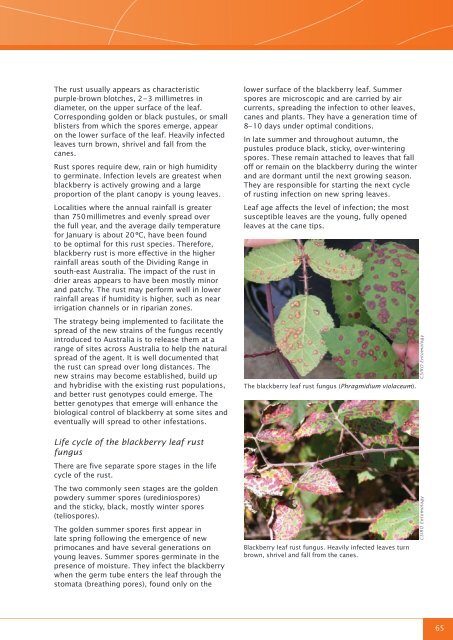Blackberry control manual - Weeds Australia
Blackberry control manual - Weeds Australia
Blackberry control manual - Weeds Australia
Create successful ePaper yourself
Turn your PDF publications into a flip-book with our unique Google optimized e-Paper software.
The rust usually appears as characteristic<br />
purple‐brown blotches, 2 – 3 millimetres in<br />
diameter, on the upper surface of the leaf.<br />
Corresponding golden or black pustules, or small<br />
blisters from which the spores emerge, appear<br />
on the lower surface of the leaf. Heavily infected<br />
leaves turn brown, shrivel and fall from the<br />
canes.<br />
Rust spores require dew, rain or high humidity<br />
to germinate. Infection levels are greatest when<br />
blackberry is actively growing and a large<br />
proportion of the plant canopy is young leaves.<br />
Localities where the annual rainfall is greater<br />
than 750 millimetres and evenly spread over<br />
the full year, and the average daily temperature<br />
for January is about 20 ºC, have been found<br />
to be optimal for this rust species. Therefore,<br />
blackberry rust is more effective in the higher<br />
rainfall areas south of the Dividing Range in<br />
south-east <strong>Australia</strong>. The impact of the rust in<br />
drier areas appears to have been mostly minor<br />
and patchy. The rust may perform well in lower<br />
rainfall areas if humidity is higher, such as near<br />
irrigation channels or in riparian zones.<br />
The strategy being implemented to facilitate the<br />
spread of the new strains of the fungus recently<br />
introduced to <strong>Australia</strong> is to release them at a<br />
range of sites across <strong>Australia</strong> to help the natural<br />
spread of the agent. It is well documented that<br />
the rust can spread over long distances. The<br />
new strains may become established, build up<br />
and hybridise with the existing rust populations,<br />
and better rust genotypes could emerge. The<br />
better genotypes that emerge will enhance the<br />
biological <strong>control</strong> of blackberry at some sites and<br />
eventually will spread to other infestations.<br />
lower surface of the blackberry leaf. Summer<br />
spores are microscopic and are carried by air<br />
currents, spreading the infection to other leaves,<br />
canes and plants. They have a generation time of<br />
8– 10 days under optimal conditions.<br />
In late summer and throughout autumn, the<br />
pustules produce black, sticky, over-wintering<br />
spores. These remain attached to leaves that fall<br />
off or remain on the blackberry during the winter<br />
and are dormant until the next growing season.<br />
They are responsible for starting the next cycle<br />
of rusting infection on new spring leaves.<br />
Leaf age affects the level of infection; the most<br />
susceptible leaves are the young, fully opened<br />
leaves at the cane tips.<br />
The blackberry leaf rust fungus (Phragmidium violaceum).<br />
CSIRO Entomology<br />
Life cycle of the blackberry leaf rust<br />
fungus<br />
There are five separate spore stages in the life<br />
cycle of the rust.<br />
The two commonly seen stages are the golden<br />
powdery summer spores (urediniospores)<br />
and the sticky, black, mostly winter spores<br />
(teliospores).<br />
The golden summer spores first appear in<br />
late spring following the emergence of new<br />
primocanes and have several generations on<br />
young leaves. Summer spores germinate in the<br />
presence of moisture. They infect the blackberry<br />
when the germ tube enters the leaf through the<br />
stomata (breathing pores), found only on the<br />
<strong>Blackberry</strong> leaf rust fungus. Heavily infected leaves turn<br />
brown, shrivel and fall from the canes.<br />
CSIRO Entomology<br />
65

















